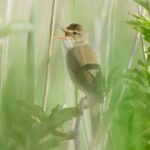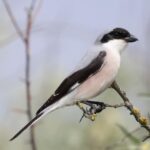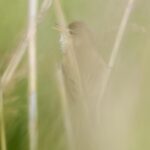The first day of a weekend of Summer birding, looking for some of our scarcer breeding birds, plus any late or early migrants as well as the regular species we can see here a this time of year. We were basing ourselves in North Norfolk today. It was a pleasant day, cloudy with sunny intervals, warm, with a lighter wind than of late.
The target for the first part of the morning was to look for raptors. As we parked at the start of a farm track, a Barn Owl flew across the meadow nearby and disappeared into the trees. Many pairs have well grown young to feed now and can be seen out hunting later into the morning and again early evening.
 Barn Owl – a very pale male, out hunting still this morning
Barn Owl – a very pale male, out hunting still this morning
As we walked along the track on the edge of the meadow, we flushed a couple of Grey Partridge from the grass, which flew off calling noisily. A Swallow was hawking for insects low over the grass. We could hear a couple of Yellowhammers and a Common Whitethroat singing from the hedges and several Skylarks singing up in the sky above the fields. We stopped to look at a young Brown Hare, a leveret, hiding in one of the tramlines across a field.
Up at the top of a rise, from where we could get a good view over the surrounding countryside, we stopped to scan for raptors. We saw an excellent variety of birds of prey from here. A Kestrel was hovering over the fields. A Sparrowhawk flew across in front of us, brief bouts of flapping interspersed with long glides. As the day warmed up, several Common Buzzards circled up out of the woods in all directions. A Red Kite hung in the air – it was some distance away, but its distinctive shape and flight action, turning its tail and flexing its wings down, easily gave its identity away. Target achieved.
It is a great spot up here from which just to stand and admire the gently rolling Norfolk countryside. A pair of Stock Doves flew over. A Green Woodpecker flew across the field in front of us, commuting between blocks of trees.With our target for the morning duly achieved, we moved on.
Our next destination for the rest of the morning was Titchwell. As we took a quick walk round the overflow car park, a pair of Mediterranean Gulls flew over, calling loudly. We had almost got right round to the other side, when a Turtle Dove finally flew out of the bushes above our heads. There has been a pair nesting here and they have just successfully fledged a single youngster, so we were hoping to see them here.
The Turtle Dove flew round to the other side of the car park, where we had just walked. We could see it perched in a tree, preening. So we headed back that way and as we stood and watched it, a second Turtle Dove flew in and landed in another tree, further back. We watched the pair of Turtle Doves for a while, they seem to be used to people in the car park now and we had great views of them close up through the scope.
 Turtle Dove – showed really well in the car park this morning
Turtle Dove – showed really well in the car park this morning
Eventually the first Turtle Dove finished preening and flew back the way it had come. The second Turtle Dove promptly flew off after it, so we moved on. Over by the Visitor Centre, there were several Greenfinches on the feeders, along with the usual selection of Chaffinches, Great Tit and Blue Tit.
As we walked out onto the reserve along the main path, we could hear a Grasshopper Warbler reeling from the grazing meadow. As we got out of the trees, we stopped to scan but we couldn’t see it – it sounded like it was down in the deep vegetation out in the middle. A couple of Marsh Harriers circled up over the reeds beyond.
A Sedge Warbler was singing in the reeds, a frenetic mixture of rattles and churrs, very different from the more metronimic Reed Warblers the other side of the path. We saw several Reed Warblers chasing round in the reeds that side. A male Reed Bunting was perched up on top of a bush, singing away, although its song is not much to write home about! We could hear Bearded Tits calling, and turned to see a family party flying up from the reeds. They kept moving a short distance at a time, and we could see them each time they came back up, a male, female and two black-masked tawny juveniles.
There was nothing of note on the Grazing Meadow ‘pool’, and just a few Mallard visible on the reedbed pool, so we made our way quickly up to Island Hide.
There has been a steady succession of Little Gulls, all 1st summer birds, on the reserve in recent weeks and we quickly found the two here today, on the nearest island. They were suitably dwarfed by the nearby Black-headed Gulls and a single Lesser Black-backed Gull. Over in the fenced off island at the back, we picked out a smart pair of Mediterranean Gulls among the nesting Black-headed Gulls. There were also a few terns – as well as the regular Common Terns, three Sandwich Terns were roosting on the island.
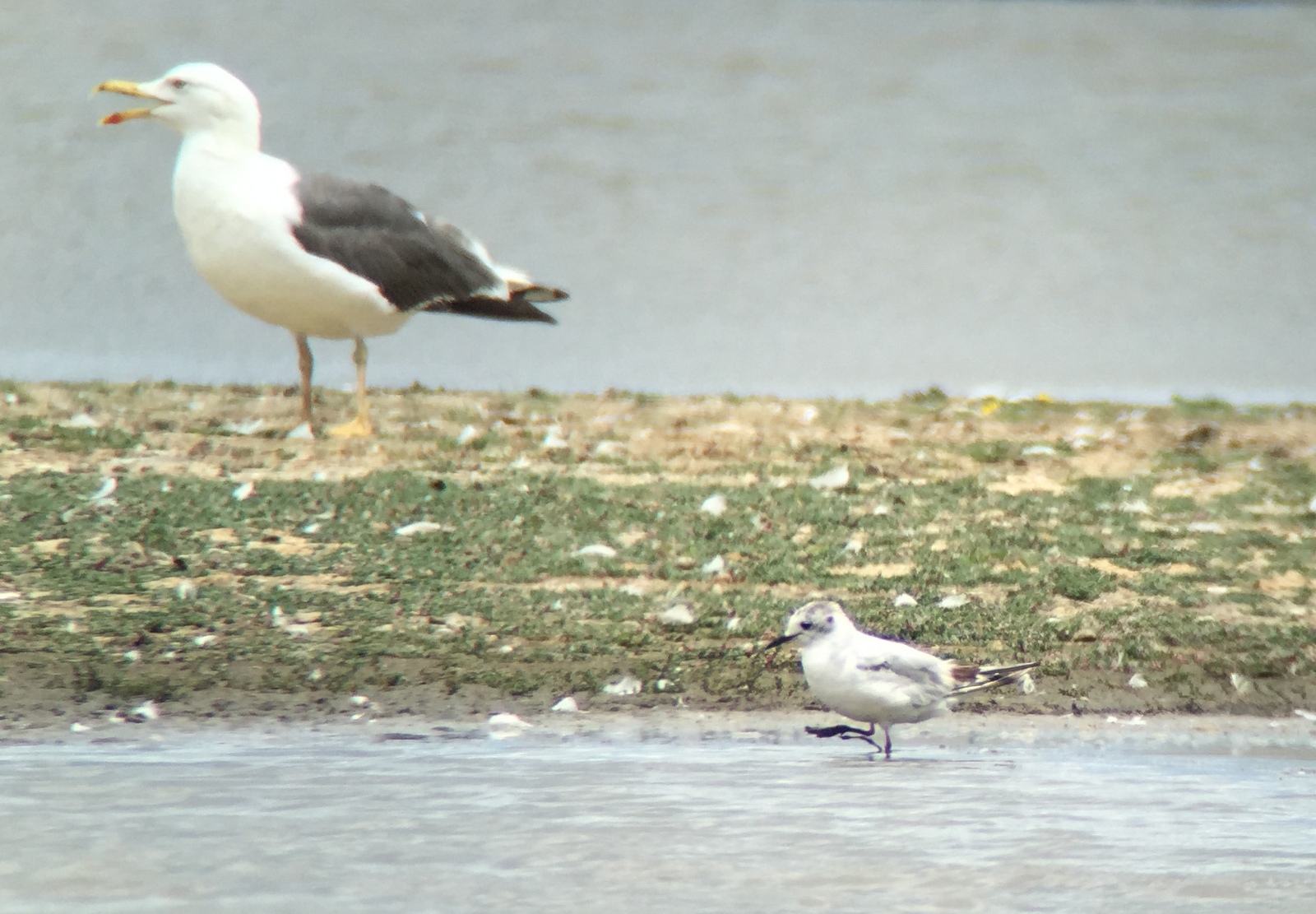 Little Gull – dwarfed by the Lesser Black-backed Gull behind
Little Gull – dwarfed by the Lesser Black-backed Gull behind
Even though it is only June still, the first waders are already starting to return, on their way south from the arctic. At first, all we found were the regular waders. There are lots of Avocets, as usual, many of them loafing over on one of the islands with a mob of Black-tailed Godwits. The majority of the latter are 1st summer Icelandic birds which have not gone north this year, although we did manage to find a single Continental Black-tailed Godwit in with them.
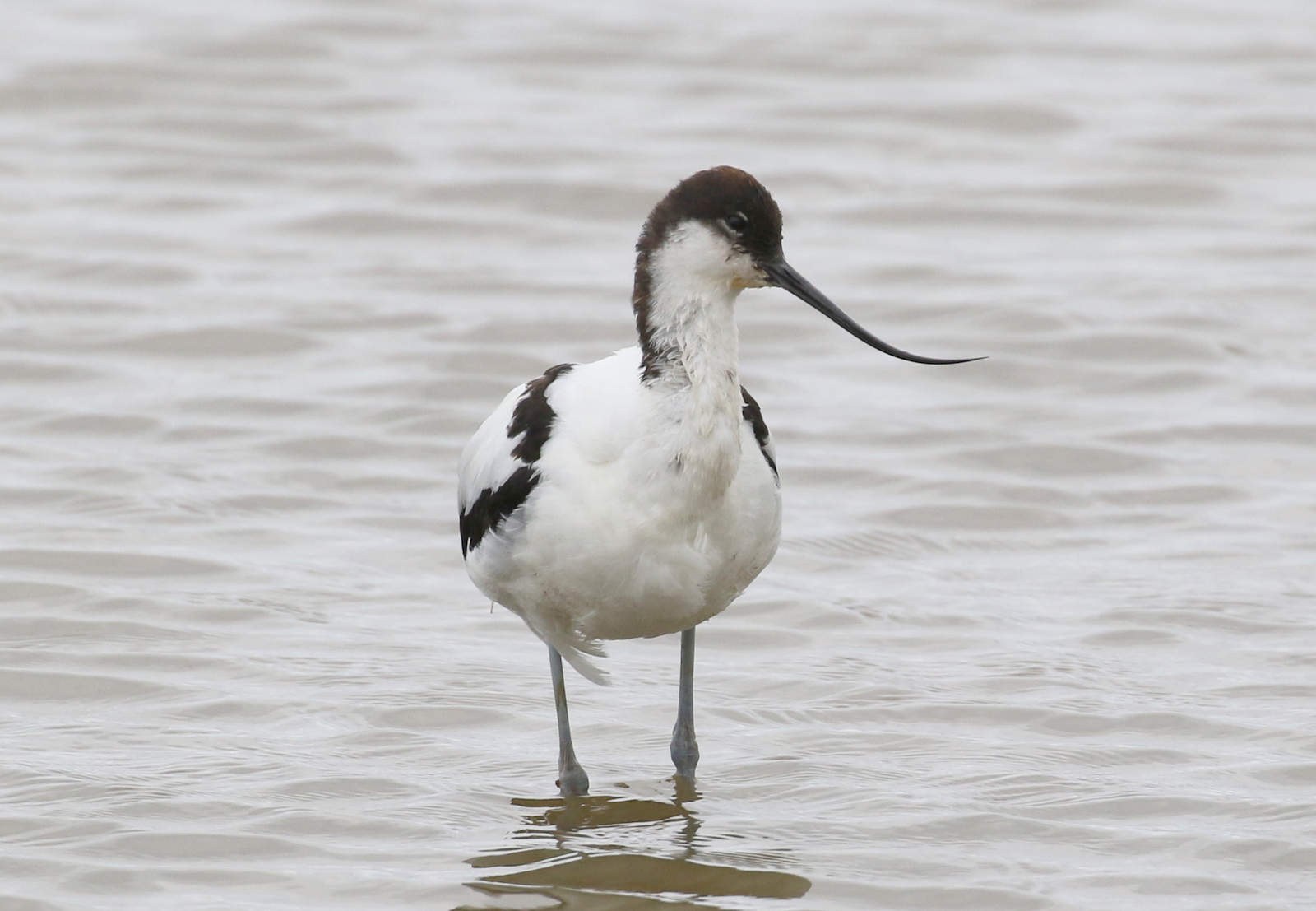 Avocet – increasing numbers on the freshmarsh
Avocet – increasing numbers on the freshmarsh
The single Ruff has been here throughout, and is also presumably a first summer bird, so a non-breeder this year. Although sporting a bright rufous head and neck, he never developed the distinctive ruff of a breeding male. There were a couple of Little Ringed Plovers too.
The wader highlight from here was a single Spotted Redshank which appeared on the edge of the reeds. A real cracker, it was in full breeding plumage, jet black with silvery white spots on its upperparts. This bird is freshly in from the arctic on its way back south. This is the time to see them at their best, as they quickly start to moult into silvery grey winter plumage and get very patchy after a week or so.
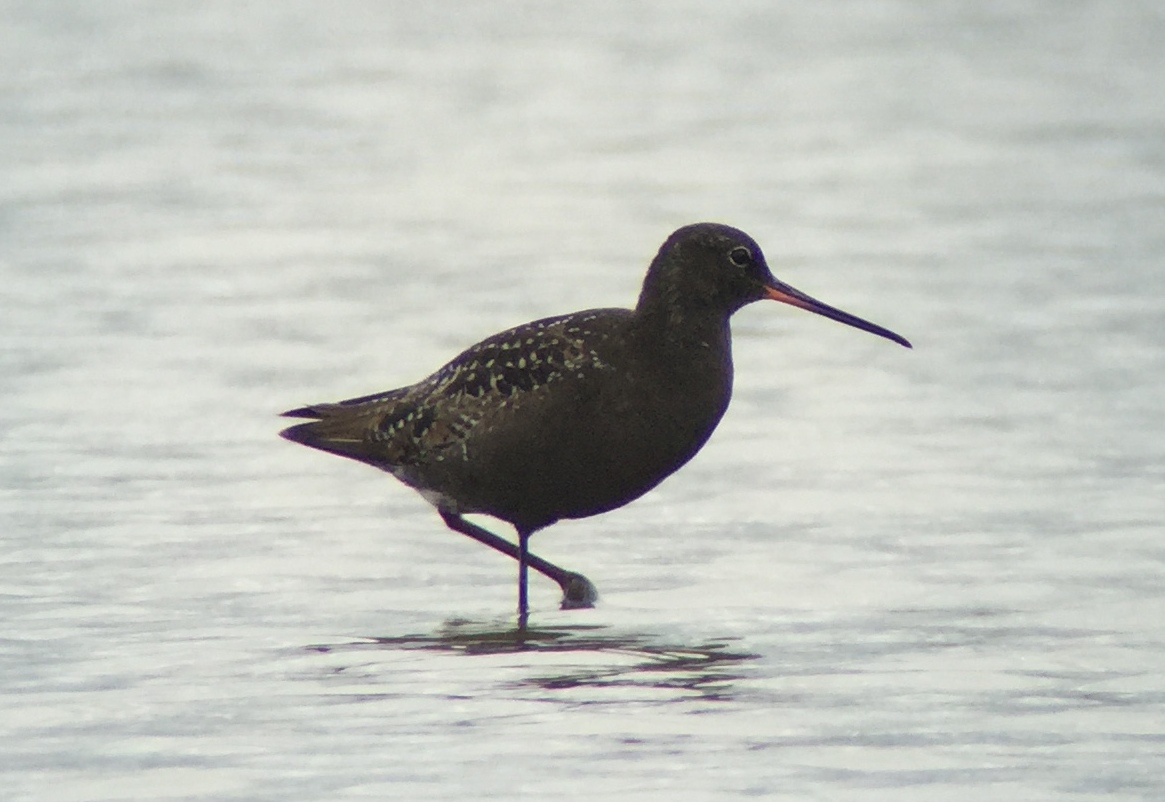 Spotted Redshank – a stunning bird in full black summer plumage
Spotted Redshank – a stunning bird in full black summer plumage
As we sat in the hide, we could see more Marsh Harriers over the main reedbed. A rather dark chocolate brown bird appeared with them, with very restricted pale on the back of the head – one of the first juvenile Marsh Harriers to fledge this year, up practicing flying. There are not so many ducks here now, and what is here is mostly drakes in eclipse. There were a few Teal, starting to moult, and the usual Shelduck.
As we made our way out along the bank, a small crowd of locals were gathered around one of the benches. They kindly pointed out a Common Sandpiper which had just appeared on one of the islands, another returning migrant wader for the day’s list.
Continuing out towards the beach, there was nothing of particular note on either the Volunteer Marsh or the Tidal Pools today. However, as we were walking past, another local birder called to us and pointed to three Spoonbills which had flown across thre freshmarsh behind us. We watched as they heading out towards Brancaster, circling for a minute or so over the saltmarsh.
A quick look at the sea produced a raft of around 30 Common Scoter out on the water. There were quite a few terns flying back and forth, which were mostly Sandwich Terns. Scanning the beach we could see a few waders down on the mussel beds, despite the disturbance from lots of people clambering over them. A Curlew was the most notable, again possibly an early returning bird, alongside several Bar-tailed Godwits and lots of Oystercatchers. A pair of Shoveler on the beach were rather out of place!
It was already lunch time and we had a long walk back ahead of us, so we didn’t linger too long on the beach. On the way, we had a quick stop when we heard some Bearded Tits calling near the path. The Bearded Tits perched up nicely in the reeds for us briefly, just as a Cetti’s Warbler did exactly the same further along, so we didn’t know which way to look.
 Bearded Tit – a pair showed well on the walk back
Bearded Tit – a pair showed well on the walk back
After a late lunch in the picnic area, we drove back east along the coast road. We stopped at Holkham and took the path to the west on the inland side of the pines. There were a few warblers singing in the trees – a Blackcap and a couple of Chiffchaffs, plus a distant Lesser Whitethroat. We heard a Jay calling in the pines too. Otherwise the trees were rather quiet, perhaps not surprising in mid afternoon.
Stopping to scan the grazing marshes, we could see the heads of quite a few geese sticking out of the long grass. Most of them were Greylag Geese – sporting bright orange carrots as bills – but a couple of darker heads and bills appeared with them. Two Pink-footed Geese walked out, probably birds which have been shot and injured and could not make the journey back north to Iceland to breed. There were also a few Canada Geese and Egyptian Geese here too.
There were a few butterflies out, in the brambles and bushes alongside the path. Mostly they were Red Admirals and Small Tortoiseshells but as we got closer to the crosstracks we found several White Admirals too.
Even before we got into the hide, we could see a huddle of white shapes on the edge of the pool. From up in the Joe Jordan Hide, we got the scope on them and confirmed they were mostly Spoonbills. There were several recently fledged juveniles with only partly grown bills – nicknamed ‘teaspoonbills’, as well a few adults still sporting nuchal crests. One of the juvenile Spoonbills decided to start harrassing its parent, chasing round after it, bobbing its head vigorously up and down, flapping its wings and begging. The adult Spoonbill tried to walk away but was pursued around the pool by the youngster.
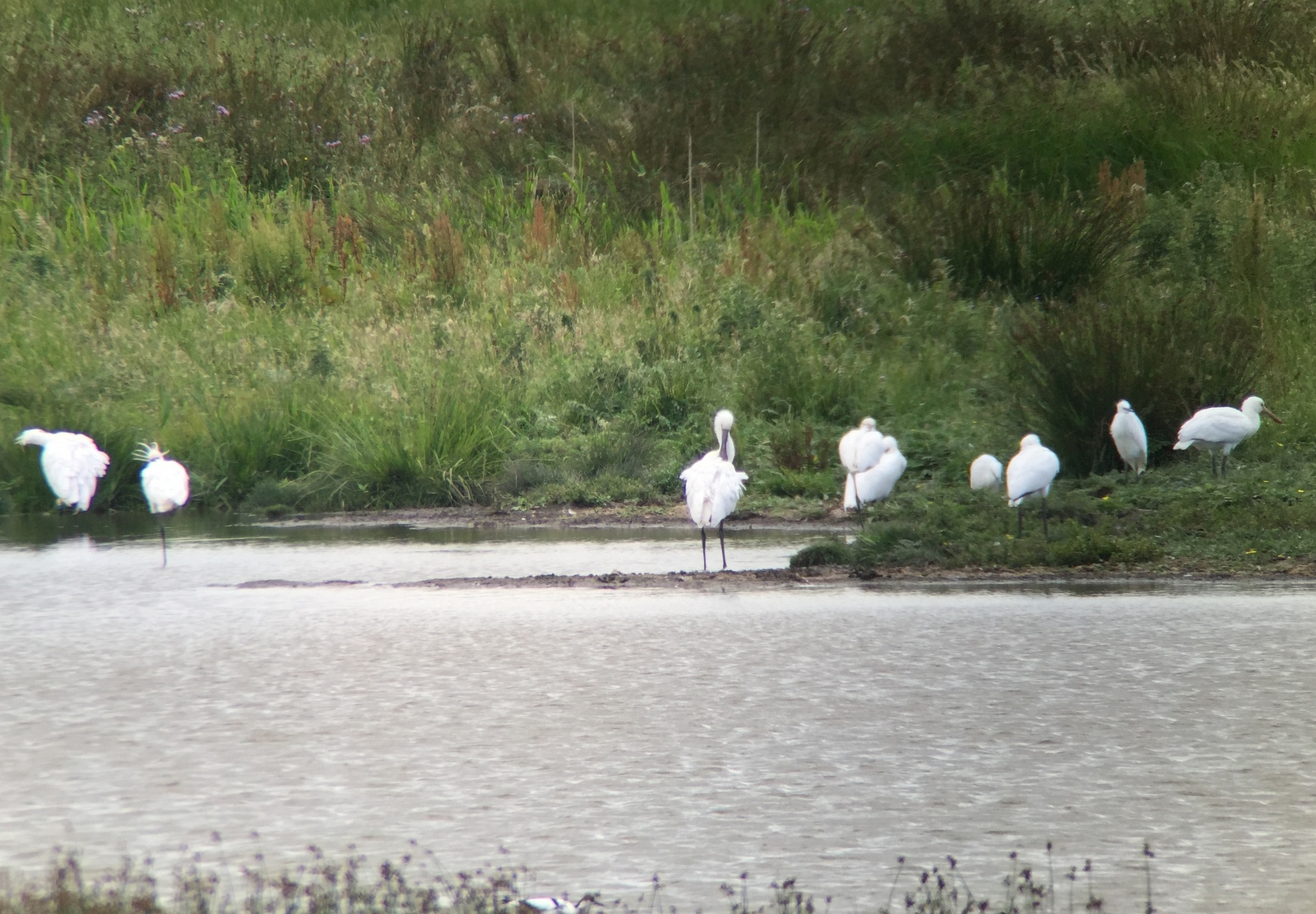 Spoonbills & Little Egrets – including some recently fledged young
Spoonbills & Little Egrets – including some recently fledged young
As well as the juvenile Spoonbills on the pool, there were two or three recently fledged Little Egrets too. There was a steady coming and going of Little Egrets, but suddenly two larger egrets appeared over the trees. They were Great White Egrets. They flew across and dropped down out of view behind the bank. A little later, we could see one Great White Egret feeding out on the grazing marsh beyond the trees.
There were plenty of Marsh Harriers here too, and a couple made nice close passes in front of the hide, giving us great views. One female in particular seemed to like hunting over the grass just to one side of the hide.
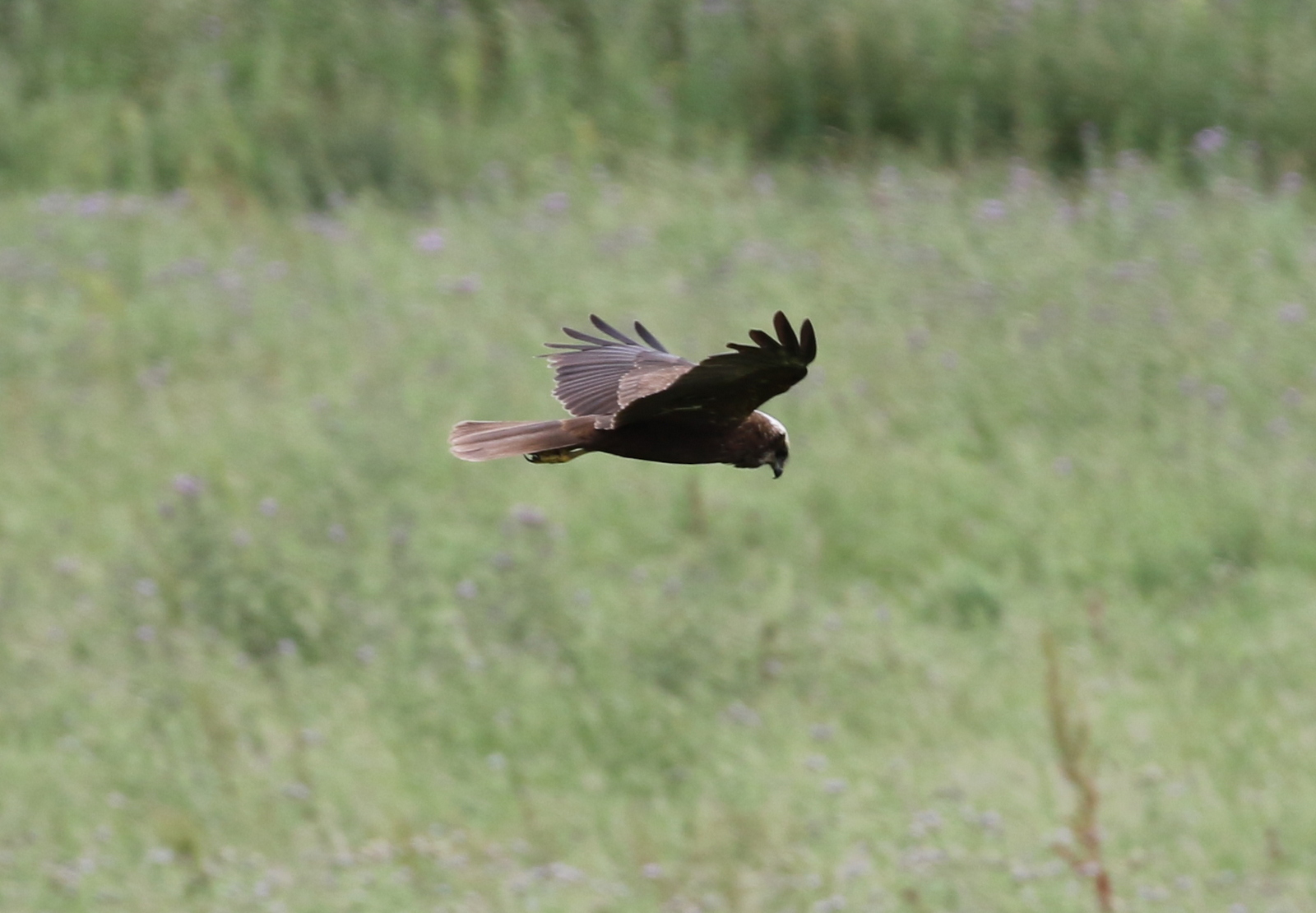 Marsh Harrier – gave great views from the hide
Marsh Harrier – gave great views from the hide
With a busy evening planned, it was time to walk back if we were to have a chance to get something to eat beforehand. On the way, we saw a few more tits in the trees. A mixed flock of Long-tailed Tits and Coal Tits had probably been down to bathe or drink and we caught them as they made their way back into the pines. At least one Goldcrest was with them. We also heard a Treecreeper calling just before we got back to the car.
After a couple of hours break, we met again later for the Nightjar Evening. The plan was to go looking for owls first, so we made our way first over to a good site for Little Owls. When we arrived at the farm buildings, there was no sign of any owls at first. A Yellowhammer was singing from the top of a tree nearby and we could see few Red-legged Partridges and a pair of Oystercatchers asleep on the roof of one of the buildings.
There were several Brown Hares around too. We had stopped at the start of a track to watch two of them when a Stoat ran across the path in front, followed by three almost fully grown young ones. A few seconds it was followed by another Stoat and another two youngsters, presumably all one family on an evening’s outing. A nice surprise.
Making our way down towards the coast next, we stopped to look at a Barn Owl hunting over a field by the road. It disappeared over the hedge at the back, and we had a look across from the next field, but it had disappeared. We went back to the first field and a second Barn Owl appeared. Again, it flew up into the hedge but this time it didn’t appear the other side. It had clearly landed, as a couple of minutes later we saw it again as it flew away along the line of the hedge.
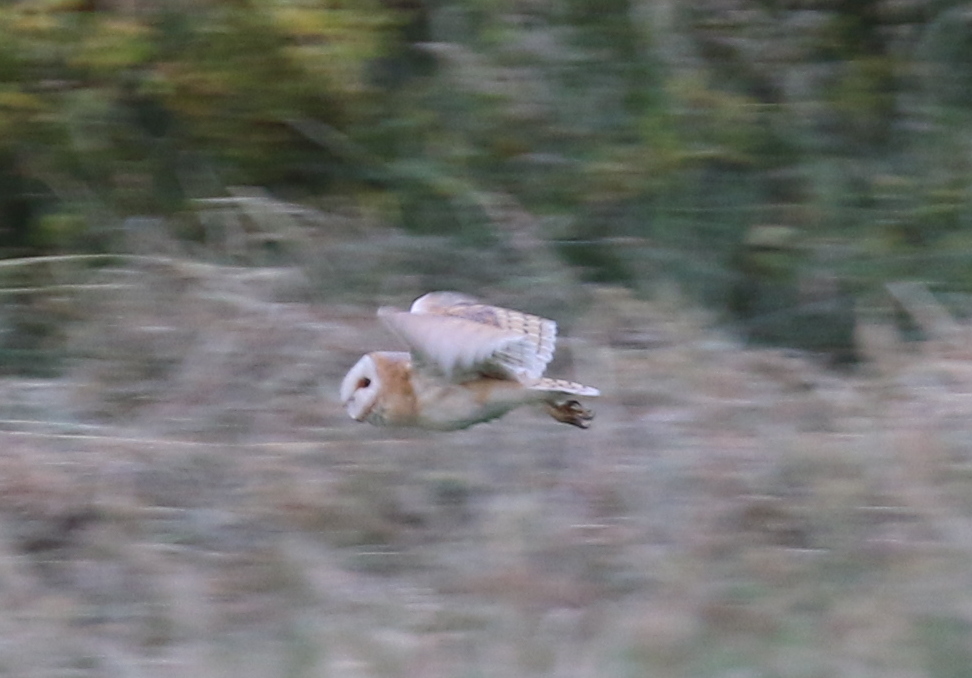 Barn Owl – one of five we saw this evening in a brief look
Barn Owl – one of five we saw this evening in a brief look
We had another stop briefly in another area where there is a pair of Barn Owls nesting in an owl box. We watched them hunting and bringing food back to the box. A third Barn Owl, a much darker bird, flew across carrying food and landed in a bush out of view. We had an appointment with some Nightjars so unfortunately we couldn’t linger here long this evening.
Up on the heath, we got ourselves in position in time for the Nightjars to start churring. They took a while to get started but then, after a brief churr, two male Nightjars appeared and started chasing each other round, in and out of the trees. One of them flew towards us and landed in an oak tree in front of us before beginning to churr. We managed to get it in the scope, but it was hard to pick out against the dark branches and it flew again before everyone could get a look at it. It flew past us, so we followed on after it.
The Nightjar had landed in another oak further across the heath. We could hear it churring so we made our way round to the side where we thought it would be perched. There it was, on a dead branch. We got it in the scope and this time everyone got a quick look at it before it flew again. This time it landed on one of its favourite perches, a dead branch which sticks out from one the trees. We crept round to where we could see it out in the open, churring away with its throat feathers puffed out, giving us great views.
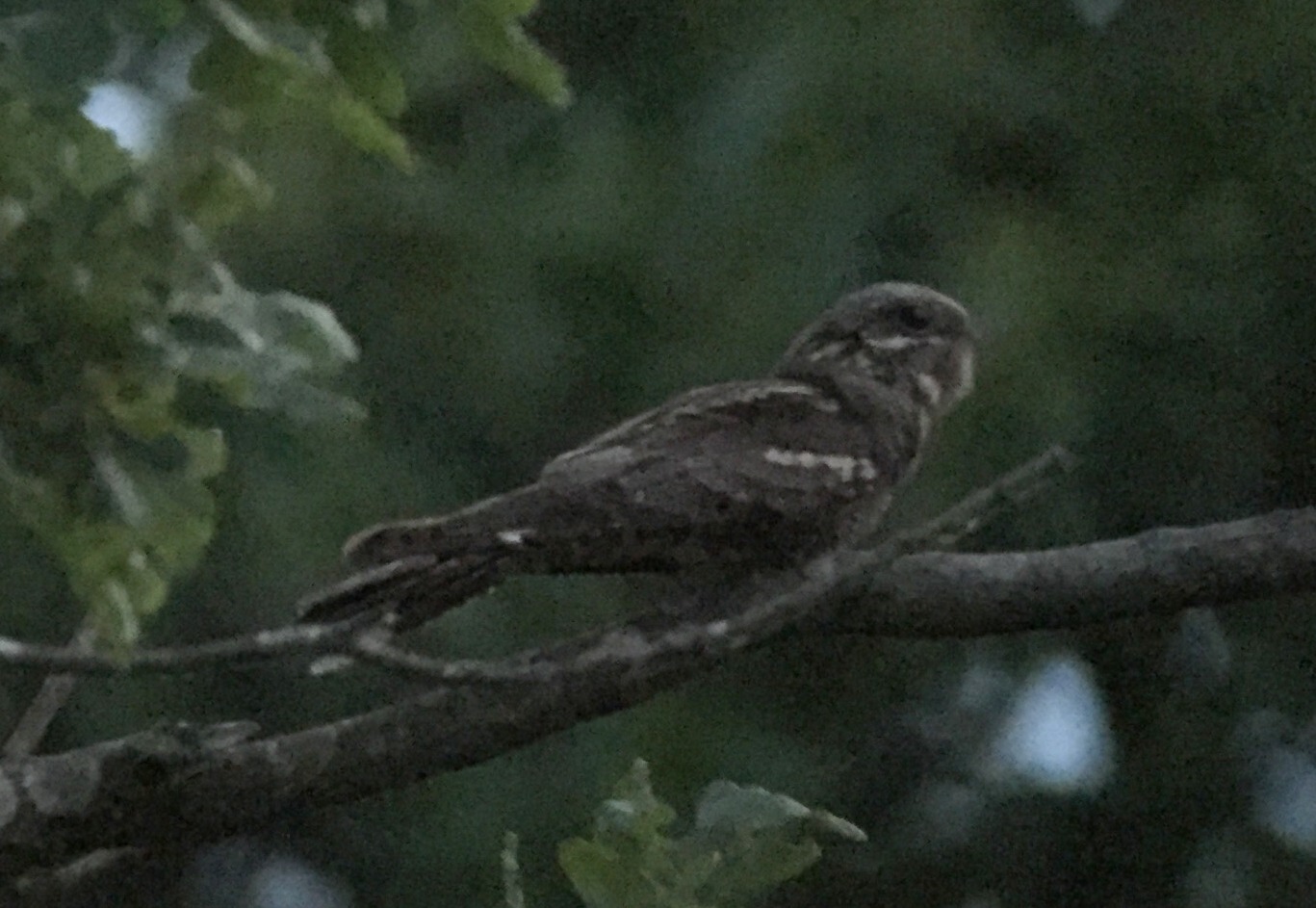 Nightjar – churring from one of its favourite branches
Nightjar – churring from one of its favourite branches
When this Nightjar finally flew off, we turned towards another male churring further over. We could see it silhouetted against the last of the evening’s light, a classic Nightjar view. We stood for a few minutes, listening to all the Nightjars churring around us, a great sound on a summer’s evening up on the heath. A Tawny Owl hooted from the trees and we could hear the squeaky call of a juvenile Tawny Owl too. Then with the light fading, we started to make our way back. A great evening to round off our first day.
